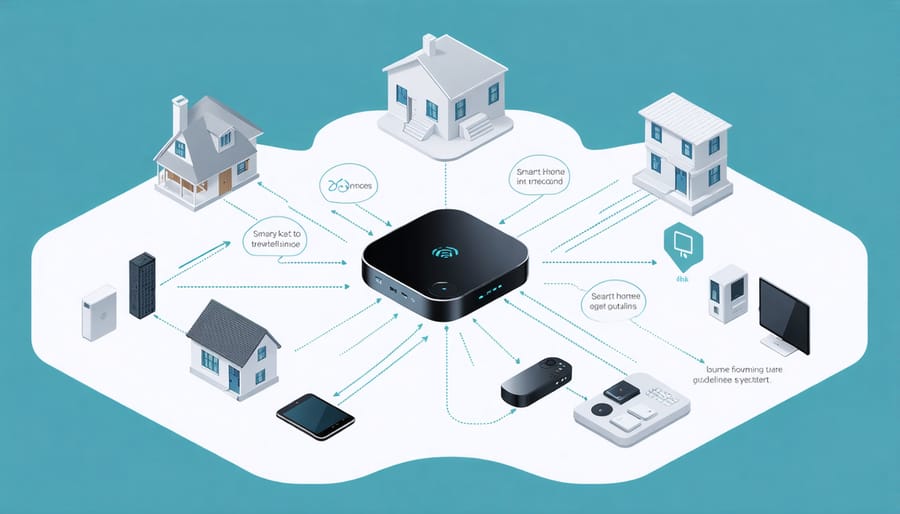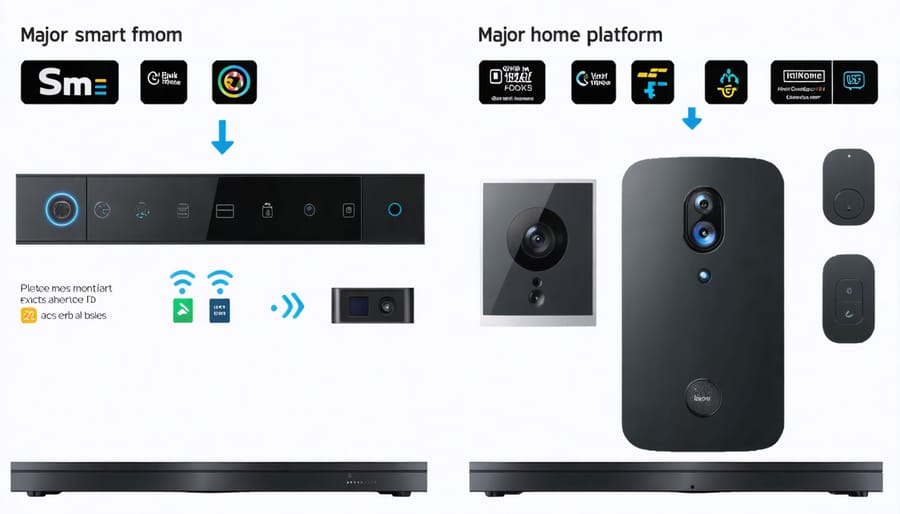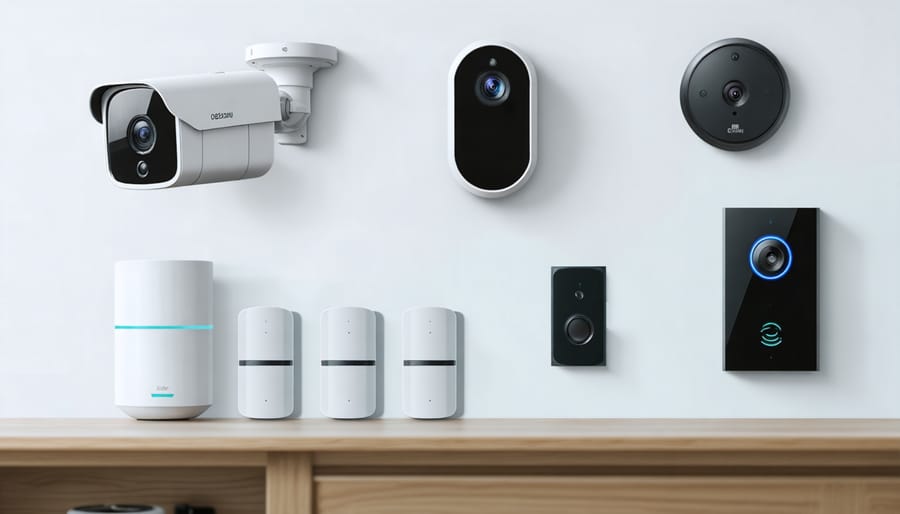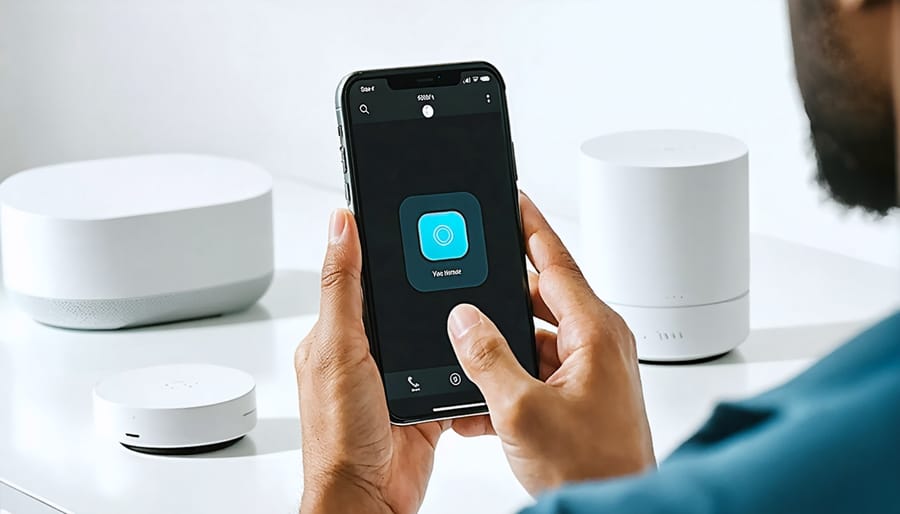Transform your entire home into an intelligent ecosystem by connecting smart devices through a centralized hub, enabling seamless automation and control from a single interface. Start with essential integrations like smart lighting, thermostats, and security cameras to transform your living space into an efficient, responsive environment. Modern smart home systems now offer unprecedented convenience, from voice-controlled appliances to AI-powered routines that learn and adapt to your daily habits.
With the average household managing 25+ connected devices by 2025, integrated smart home systems have evolved from luxury to necessity. These systems not only enhance comfort and security but also optimize energy usage, potentially reducing utility bills by 10-30%. Whether you’re building a new smart home infrastructure or upgrading existing devices, today’s integration platforms offer plug-and-play simplicity alongside powerful automation capabilities that work seamlessly across different brands and protocols.
Understanding Smart Home Integration Basics
What Makes a Home ‘Smart’?
A smart home is more than just a collection of gadgets – it’s an interconnected ecosystem where devices work together seamlessly to enhance your daily life. At its core, a smart home relies on three fundamental components: smart devices, a central hub or controller, and a reliable internet connection.
Smart devices are the building blocks of your connected home. These can include everything from smart lighting and thermostats to security cameras and door locks. Each device comes equipped with sensors and wireless communication capabilities, allowing them to gather information about your home environment and respond to commands.
The central hub acts as the brain of your smart home, coordinating communication between devices and enabling them to work together intelligently. This could be a dedicated smart home hub, a virtual assistant device like Amazon Echo or Google Home, or even your smartphone running a home automation app.
What truly makes a home “smart” is the ability for these components to communicate and work together automatically. For example, when your smart doorbell detects motion, it can trigger your outdoor lights to turn on, while simultaneously sending a notification to your phone and recording video footage. This kind of automated coordination happens through wireless protocols like Wi-Fi, Zigbee, or Z-Wave.
The real magic happens when these systems learn your preferences and habits, creating automated routines that anticipate your needs – like adjusting your thermostat before you wake up or turning off all lights when you leave for work.

Key Integration Platforms
The smart home landscape is dominated by three major platforms that make managing your connected devices a breeze. Google Home offers a user-friendly interface and excellent voice recognition through Google Assistant, making it perfect for Android users and those already invested in Google’s ecosystem. Its strength lies in natural language processing and seamless integration with popular services like YouTube, Gmail, and Google Calendar.
Apple HomeKit stands out for its robust security features and tight integration with iOS devices. If you’re an iPhone user, you’ll appreciate the simple setup process – just scan a QR code, and you’re ready to go. HomeKit’s focus on privacy means all your data stays encrypted and secure, though you might find fewer compatible devices compared to other platforms.
Amazon Alexa has perhaps the widest range of compatible devices and skills. The platform excels at customization, allowing you to create complex routines and automation sequences with ease. Whether you want to control lights, adjust thermostats, or manage security cameras, Alexa’s extensive third-party support means you’ll likely find what you need.
Each platform offers its own mobile app, voice control capabilities, and automation features. While you can mix and match devices from different platforms, sticking to one ecosystem usually provides the smoothest experience. Consider your existing devices and preferred smartphone platform when choosing your smart home hub – this will help ensure a more integrated and hassle-free setup.

Essential Smart Home Device Categories
Lighting and Climate Control
Transforming your home’s lighting and climate control through smart integration offers both comfort and efficiency. Modern smart bulbs allow you to create perfect ambiance with adjustable brightness and color temperatures, while automated schedules ensure lights turn off when rooms are empty. Many systems now support voice commands and smartphone control, making it easier than ever to manage your home’s illumination.
Smart thermostats represent a major leap forward in energy management solutions, learning your preferences and automatically adjusting temperatures based on your daily routines. These devices can detect when you’re away and adjust settings accordingly, helping reduce energy waste while maintaining comfort.
Climate sensors work alongside your thermostat to create a more comprehensive environment control system. They monitor humidity, air quality, and temperature across different rooms, ensuring consistent comfort throughout your home. Some advanced sensors can even trigger automated responses, like activating air purifiers when pollution levels rise or adjusting humidity when levels fall outside optimal ranges.
For optimal performance, consider integrating these components to work together. For instance, your system can automatically dim lights in the evening while adjusting the temperature for better sleep, or brighten rooms gradually in the morning while warming the house to your preferred daytime temperature. This seamless coordination not only enhances comfort but also maximizes energy efficiency.
Security and Monitoring
Today’s smart security systems offer unprecedented peace of mind while seamlessly integrating with your home automation setup. The cornerstone of any smart home security setup typically includes smart cameras, video doorbells, and motion sensors working in harmony.
Smart cameras have evolved beyond simple recording devices. They now offer features like facial recognition, night vision, and two-way audio communication. Place them strategically around your property’s exterior and in key indoor areas for comprehensive coverage. Many models even include AI capabilities that can distinguish between people, pets, and vehicles, reducing false alerts.
Video doorbells have become a must-have feature, allowing you to see, hear, and speak with visitors whether you’re home or away. These devices capture package deliveries, deter porch pirates, and provide valuable evidence if needed. Most models integrate seamlessly with your smartphone, enabling real-time notifications and video recordings.
Security sensors form the invisible shield around your home. Door and window sensors alert you to unexpected entry, while motion detectors monitor indoor and outdoor spaces. Modern sensors are smart enough to reduce false alarms from pets or falling leaves, and many can detect environmental threats like smoke, carbon monoxide, or water leaks.
The beauty of these security components lies in their interconnectivity. When properly integrated, they create a comprehensive security network that you can monitor and control from anywhere using your smartphone or tablet. Many systems also offer professional monitoring services for additional peace of mind.

Entertainment and Convenience
Transform your living space into an entertainment hub with smart home integration that puts convenience at your fingertips. Smart speakers like Amazon Echo or Google Nest serve as central command centers, allowing you to control your entertainment systems with simple voice commands. Want to watch your favorite show? Just ask, and your smart TV will power on and tune to the right channel.
Modern smart TVs integrate seamlessly with other devices, enabling you to create the perfect movie night atmosphere with a single command. Dim the lights, lower the blinds, and adjust the room temperature – all without leaving your comfortable spot on the couch. Many smart TVs also feature built-in streaming services and can be controlled through your smartphone or tablet.
Appliance automation takes convenience to the next level. Program your coffee maker to brew your morning cup just as you wake up, or start the dishwasher during off-peak energy hours. Smart plugs can transform regular appliances into automated devices, letting you schedule when they turn on and off.
For music lovers, multi-room audio systems can follow you throughout your home, playing your favorite tunes in perfect sync across different rooms. Want to check who’s at the door while watching TV? Your video doorbell feed can appear right on your TV screen, keeping you connected without interrupting your entertainment.
Remember to group related devices into scenes for one-touch control. A “Movie Night” scene could automatically adjust your TV settings, dim the lights, and set the perfect room temperature – all with a single command.
Setting Up Your Smart Home System
Planning Your Integration
Before diving into smart home technology, taking time to plan your integration strategy can save you both time and money. Start by conducting a thorough assessment of your living space and daily routines. Which areas of your home would benefit most from automation? Common starting points include lighting, security, climate control, and entertainment systems.
Make a list of your must-have features versus nice-to-have additions. Consider your budget not just for initial purchases, but also for potential subscription fees and future expansions. It’s often wise to start with one ecosystem (like Google Home, Amazon Alexa, or Apple HomeKit) and build around it to ensure smooth compatibility.
When selecting devices, check their compatibility with your chosen ecosystem and your existing home network. Look for products that use standard protocols like Wi-Fi, Zigbee, or Z-Wave. Don’t forget to consider your home’s infrastructure – older homes might need additional hardware like mesh Wi-Fi systems or signal extenders for reliable coverage.
Think about who will be using these systems. If you share your home with family members or roommates, choose devices with intuitive interfaces and multiple user support. Also consider your technical comfort level – while some systems require minimal setup, others might need more advanced configuration.
Remember to plan for future expansion. Choose a hub or central system that can grow with your needs and support additional devices as your smart home evolves.
Network Requirements
A reliable network connection is the backbone of any smart home system. For optimal performance, you’ll want a strong Wi-Fi signal throughout your home, with speeds of at least 100 Mbps for seamless operation of multiple devices. Consider installing Wi-Fi mesh systems or range extenders to eliminate dead zones, especially in larger homes or properties with thick walls.
Your router should support both 2.4GHz and 5GHz frequencies, as different smart devices may require specific bands. While 5GHz offers faster speeds, 2.4GHz provides better range and wall penetration – perfect for devices in distant corners of your home.
Security is paramount when setting up your smart home network. Start by changing your default router password and enabling WPA3 encryption if available. Create a separate guest network for your smart devices to keep them isolated from your main network where you handle sensitive information. This adds an extra layer of protection against potential security breaches.
Regular firmware updates for your router and smart devices are essential to patch security vulnerabilities. Enable automatic updates whenever possible, and make a habit of checking for updates monthly. Consider implementing a network monitoring solution to alert you of suspicious activities or unauthorized device connections.
Remember to document your network passwords and security settings in a secure location, and regularly back up your smart home configuration settings to prevent losing your carefully crafted automations.
Installation and Configuration Tips
Setting up your smart home system doesn’t have to be overwhelming. Start by choosing a central hub that matches your needs – popular options include Amazon Alexa, Google Home, or Apple HomeKit. Once you’ve selected your hub, follow these simple steps for a smooth integration:
1. Position your hub centrally in your home for optimal connectivity
2. Download the associated mobile app and create an account
3. Connect your hub to your home’s Wi-Fi network
4. Enable necessary permissions and complete initial setup
When adding new devices, start with one category (like lighting or security) and expand gradually. Always ensure your devices are compatible with your chosen ecosystem before purchasing. Here’s a pro tip: create a network diagram marking the location of each device to help with troubleshooting later.
For optimal performance:
– Keep your router updated and centrally located
– Use a dedicated 2.4GHz network for smart devices
– Name devices clearly and logically (e.g., “Kitchen Lights” instead of “Light 1”)
– Create device groups for easier control
– Set up backup power for critical devices
Remember to regularly update both your hub and device firmware to maintain security and functionality. If you’re experiencing connectivity issues, try resetting the problematic device before attempting more complex solutions. Start with basic automations first, then gradually build more complex scenarios as you become comfortable with the system.
Maximizing Your Smart Home’s Potential
Creating Custom Routines
Creating personalized automated home routines is where the magic of smart home integration truly comes to life. Think of routines as your home’s choreography – a series of actions that play out exactly as you want them to, when you want them to.
Start small by setting up a morning routine: your blinds gradually open at sunrise, the coffee maker starts brewing, and your favorite playlist begins playing at just the right volume. As you get more comfortable, layer in more sophisticated sequences. For example, create an “Away” routine that arms your security system, turns off all lights, adjusts the thermostat, and ensures your robot vacuum starts its cleaning cycle.
Here’s a pro tip: consider your daily patterns when creating routines. What tasks do you repeatedly do at specific times? These are prime candidates for automation. Remember to include conditional triggers – like having your outdoor lights turn on only after sunset, or running your smart sprinklers only when it hasn’t rained.
Don’t forget to test your routines thoroughly before relying on them. Start with simple sequences and gradually add complexity. Most importantly, make sure to include override options for those times when you need to deviate from the usual schedule. Your smart home should adapt to your life, not the other way around.
Voice Control and Mobile Apps
Voice control has revolutionized how we interact with our smart homes, making daily tasks effortless and intuitive. Whether you’re using Amazon Alexa, Google Assistant, or Apple’s Siri, these virtual assistants serve as the cornerstone of a truly personalized smart home experience.
Mobile apps complement voice control beautifully, offering detailed control and visualization of your smart home system. Most major brands provide user-friendly apps that let you manage everything from lighting and temperature to security cameras and door locks, all from your smartphone. The real magic happens when you use both methods together – voice for quick commands and mobile apps for more complex operations.
Here’s how to make the most of both control methods:
For voice control:
– Place smart speakers strategically throughout your home
– Create simple, memorable command phrases
– Set up routines for common tasks
– Use voice groups to control multiple devices at once
For mobile apps:
– Organize devices by room or function
– Set up quick-access widgets
– Enable push notifications for important alerts
– Create automated schedules
– Share access with family members
Remember to keep your voice commands consistent and your app interfaces organized. This dual-control approach ensures you’ll always have convenient access to your smart home features, whether your hands are full or you need precise control over specific settings.

As we’ve explored throughout this guide, smart home integration systems have transformed from a luxury into an increasingly essential part of modern living. The ability to control lighting, security, climate, and entertainment from a single interface has made our homes more efficient, comfortable, and secure than ever before.
The future of smart home integration looks incredibly promising. With the continued advancement of AI and machine learning, our homes will become even more intuitive, learning from our habits and automatically adjusting to our preferences. The integration of voice control and gesture recognition is becoming more sophisticated, making interaction with our smart homes feel more natural and seamless.
For those just starting their smart home journey, remember that you don’t need to implement everything at once. Start with the basics – perhaps a smart thermostat or lighting system – and gradually expand your setup as you become more comfortable with the technology. The key is choosing compatible devices and platforms that can grow with your needs.
As technology continues to evolve, we can expect to see more emphasis on energy efficiency, enhanced security features, and improved integration between different manufacturers’ devices. The push towards standardization through protocols like Matter will make it easier for consumers to mix and match devices without worrying about compatibility issues.
Whether you’re a tech enthusiast or simply looking to make your home more convenient and efficient, smart home integration systems offer something for everyone. By staying informed about new developments and carefully planning your setup, you can create a smart home that truly enhances your daily life while preparing for the exciting innovations yet to come.
